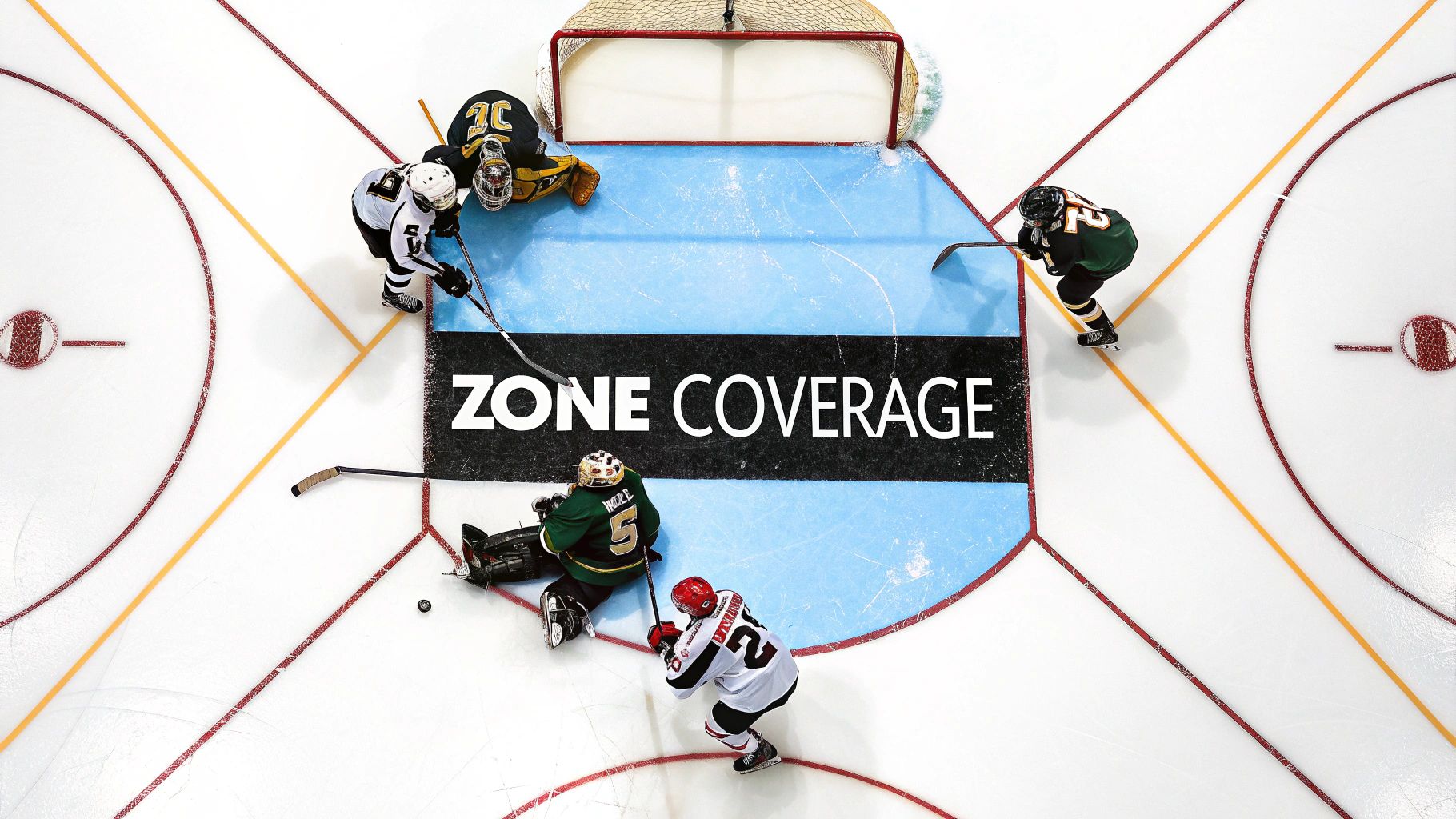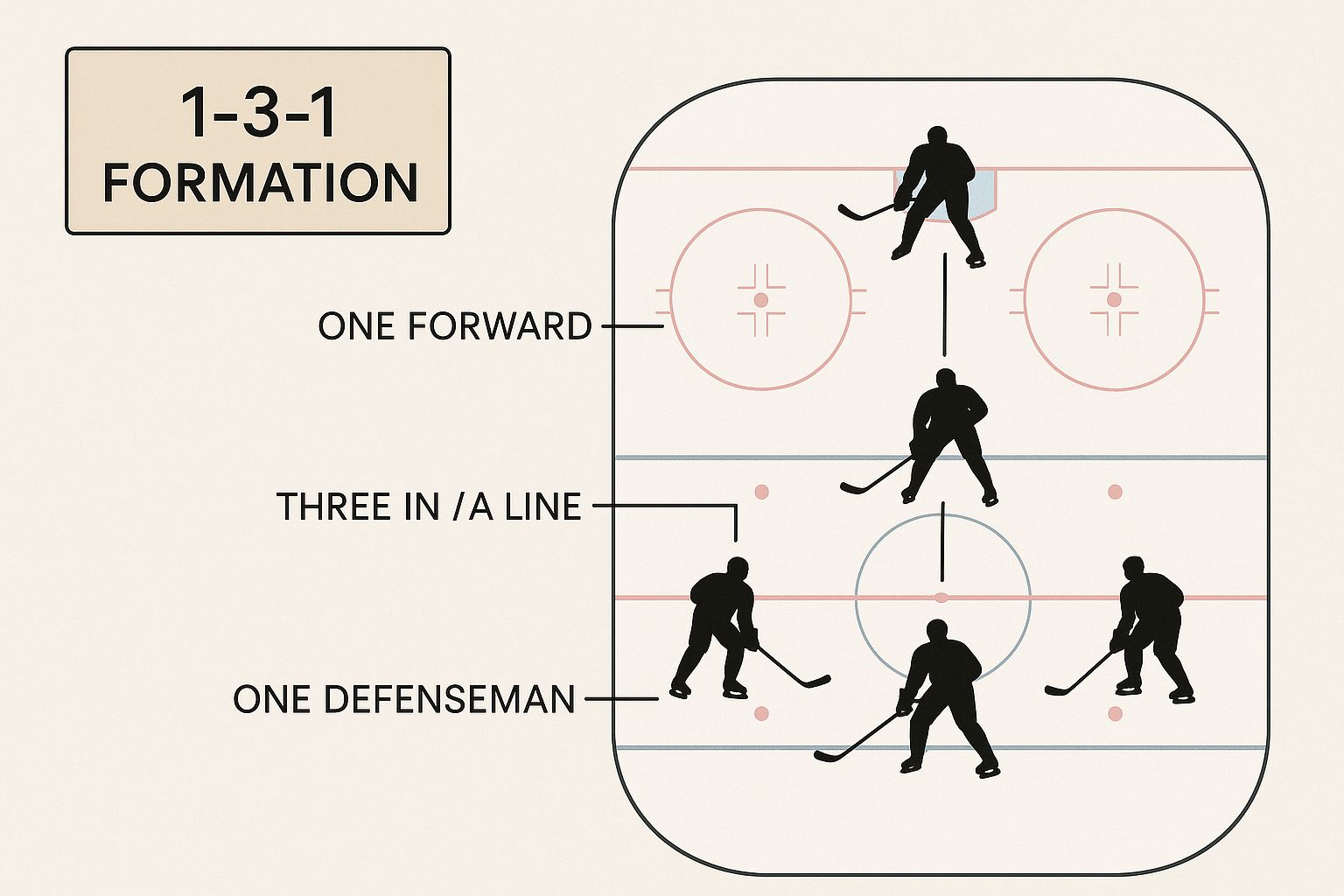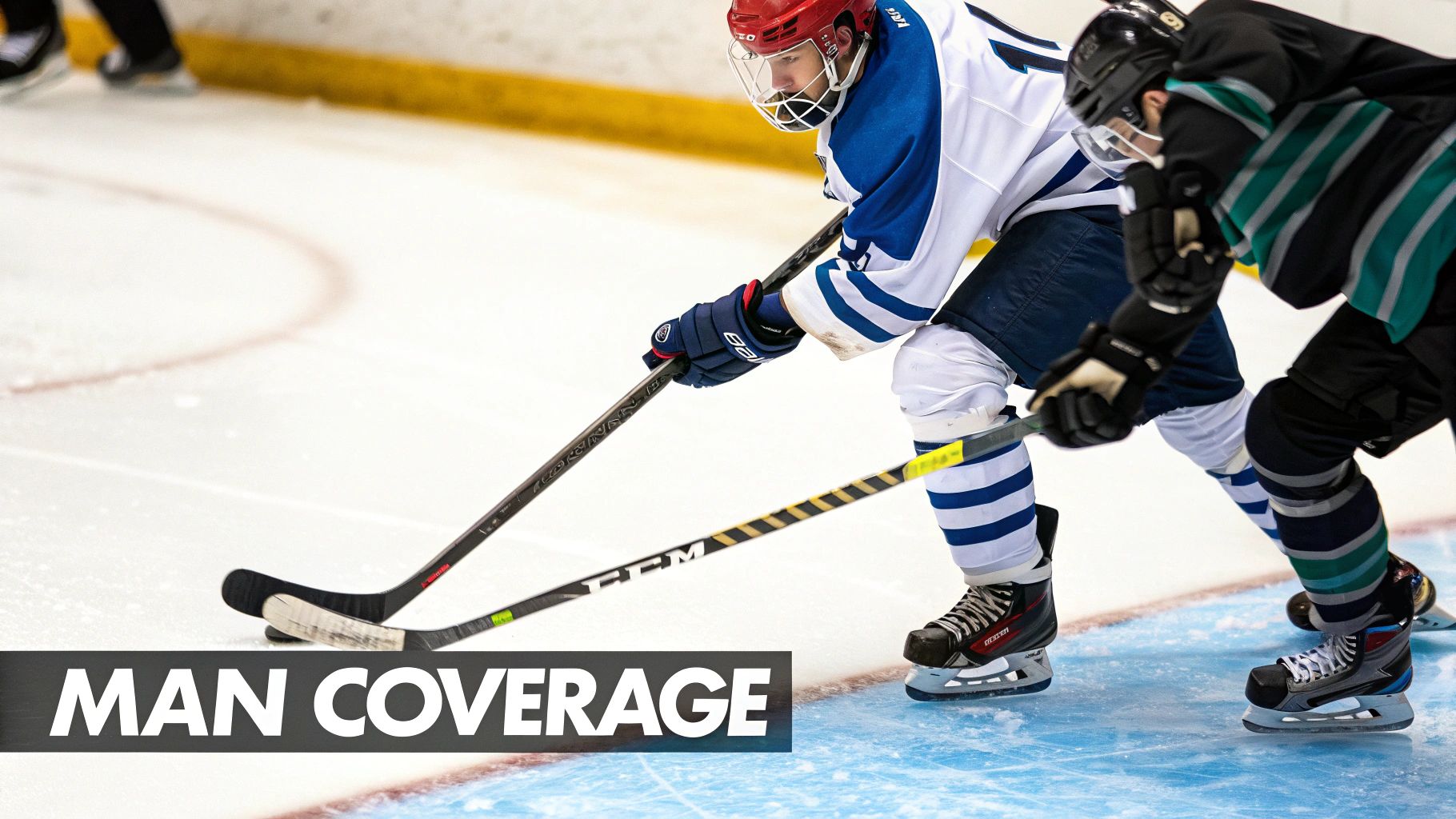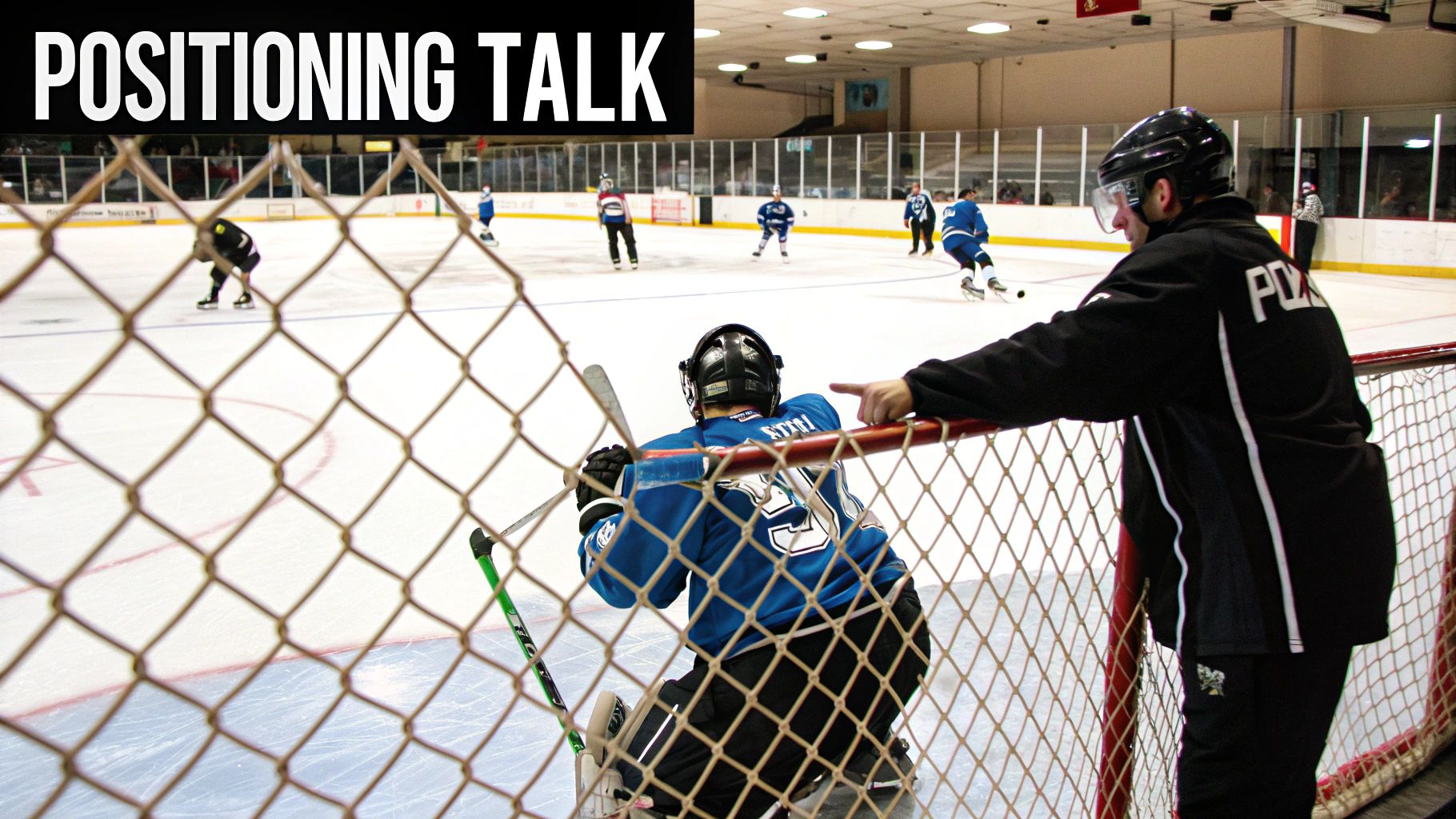Mastering Hockey Defensive Zone Coverage

Ask any coach, and they’ll tell you that games are won and lost in your own end. Defensive zone coverage is the system a team uses to get the puck back and shut down scoring chances—it’s the playbook that dictates who goes where when the other team has possession.
The main goal? Protect the most dangerous ice on the rink: the slot.
Why Defensive Zone Coverage Matters
Good defensive coverage isn’t just about chasing the guy with the puck. It’s a coordinated, five-player effort designed to suffocate the other team's offence and turn a dangerous situation into a breakout the other way. Without a clear system, you get chaos, blown assignments, and goals against.
The whole point is to take control of your own zone. When an opponent has the puck, your job is to dictate where they can and cannot go. A tight defensive shell forces attackers to the outside, keeping them away from prime shooting locations and cutting off those dangerous second-chance opportunities off rebounds.
The Foundation of a Strong Defence
When a team gets its defensive system right, everything else falls into place. The benefits are huge:
- Reduces High-Danger Chances: It’s all about protecting the slot—that area right in front of the net where most goals are scored. A good system clogs it up.
- Creates Predictability: When everyone knows their job, they can support each other without thinking. This leads to quicker decisions and smoother defensive rotations.
- Enables Quick Transitions: Winning the puck back cleanly is the first step to a fast counter-attack. A structured defence makes that happen.
- Builds Goalie Confidence: A reliable defence lets the goalie see shots clearly and control rebounds, which is a massive confidence booster.
This stuff isn't just theory; you see it play out in the NHL all the time. For example, analysis of teams like the Montreal Canadiens has shown how a shaky hybrid system can lead to mismatches and a flood of goals from the slot. In those cases, a shift to a pure zone defence—where players guard areas instead of chasing specific opponents—can be a game-changer. The data suggests this kind of strategic tweak can cut down slot shots by 10-15%. You can read more on how defensive systems impact NHL teams on Sportsnet.ca.
The best defence isn't just about preventing goals; it's the engine that drives your entire game. A successful breakout starts with a well-organized defensive stand, turning puck recovery into offensive momentum.
Mastering defensive zone coverage really comes down to controlling space and dictating the pace of the game. It’s a skill that has a massive impact on a player's overall value, something you can see in advanced stats. If you want to dig deeper into how individual contributions are measured, check out our guide that explains what Wins Above Replacement (WAR) is in hockey.
Breaking Down the Core Defensive Systems
To really get what’s happening in defensive zone coverage, you have to look past the buzzwords and see how these systems actually play out on the ice. Every strategy is basically a playbook, giving all five skaters specific jobs to turn a chaotic puck battle into a structured, predictable defensive front. Every player needs to know their assignment based on where the puck is and where the opponents are headed.
The three big systems you'll see—man-to-man, zone, and hybrid—all offer a different flavour for shutting down an attack. The system a coach picks usually comes down to their team's roster, their own philosophy, and what kind of offence the other team is running. Let's break down how each one works in a real game.
The Man-to-Man Coverage System
The easiest concept to wrap your head around is man-to-man coverage. Just like it sounds, each of the five defenders gets assigned to a specific opponent, and their job is to stick to them no matter where they go in the defensive zone. If your guy skates behind the net, you're right there with him. If he drifts out to the blue line, you’re in his pocket.
This system is all about individual responsibility. There's no confusion about who is supposed to be covering who, which keeps things simple when the pressure is on.
But that strength is also its biggest weakness. Smart offensive players are masters at creating chaos with picks and crossovers, forcing defenders to chase them through traffic. This can completely pull a defensive structure apart, leaving a huge hole in the slot if even one defender gets beat.
The Pure Zone Defence
On the flip side, a pure zone defence has players defending specific areas of the ice, not specific opponents. Picture the defensive zone sliced up into five distinct territories, with each player responsible for patrolling their patch. The whole point is to keep a tight, organised formation—often looking like a box or triangle right in front of the net.
When the puck carrier moves from one player's zone to another, the responsibility gets handed off seamlessly.
The core idea of a zone defence is to protect the most dangerous ice. By holding their positions, defenders can clog up passing lanes, block shots, and collapse on anyone who dares to enter the high-danger scoring area.
This style stops defenders from getting dragged out of position and keeps bodies in front of the net. The main challenge? It demands constant communication and flawless coordination. If players aren’t talking as opponents weave between zones, an assignment will get blown, leaving an attacker wide open for a tap-in.
Here’s a look at a typical defensive zone layout.

You can see the critical areas defenders have to lock down, especially that prime real estate in the slot right in front of the crease.
The Modern Hybrid System
As the game has gotten faster and smarter, most NHL teams now run a hybrid system that mixes elements of both man-to-man and zone coverage. This adaptable approach lets teams switch gears depending on the situation. For example, a team might play a zone when the puck is pinned on the boards but flip to man-to-man coverage the second an opponent cuts into the slot. A well-oiled hybrid system is incredibly tough to beat, particularly on the penalty kill. To see how these strategies affect results, you can check out detailed breakdowns of current NHL special teams rankings.
The hybrid system gives coaches the best of both worlds, but it's also the toughest to pull off. It requires a high hockey IQ and non-stop communication from all five skaters to make sure everyone is on the same page.
Mastering Elite Defensive Positioning

Great defence isn’t about scrambling around your own end, frantically blocking shots. Elite hockey defensive zone coverage is calm, controlled, and almost looks easy. It’s all about anticipating where the play is going and getting into position before the puck arrives.
When players master their positioning, they dictate what the other team can and can't do. By keeping the right gaps and angles, they shrink the ice, steer attackers into harmless areas, and choke off dangerous passing lanes. It’s a proactive game of chess, not a reactive game of checkers.
The Critical 10 Second Rule
A core principle drilled into players in Canadian hockey development is the "10 Second Rule." This isn't just a friendly guideline—it's a hard deadline for getting the puck out of your zone. The rule is simple: once your team gets possession in your own end, you have ten seconds to move it out.
Wait any longer, and the odds of a turnover skyrocket. The other team gets organized, sets up their forecheck, and traps you. This rule forces quick thinking and decisive action, turning defence into offence in a heartbeat.
Protecting the House with the DICE Formation
To support that quick exit, teams need a strong defensive structure. One of the most effective is the DICE formation. Think of the number five on a die: four dots in the corners and one in the middle. That's exactly how players should set up to protect the most valuable ice on the rink: "the house."
This setup ensures every key lane to the net is plugged, forcing the attack to the outside. The jobs are simple and clear:
- Two Defencemen: They lock down the front of the net and the low slot. Their job is to stop screens, tie up sticks, and clear out rebounds.
- Centre: Takes the high slot, supporting the D-men down low but also ready to cut off passes out to the point.
- Two Wingers: They sag down to cover the tops of the circles on their side, getting in shooting lanes from the point and pressuring the puck carrier.
This coordinated five-player unit is a staple taught by organizations like Hockey Canada. Teams that truly master the DICE formation see a massive drop in quality chances against them. In fact, top teams in Canadian junior leagues can reduce high-danger scoring opportunities by 15-20% per game—a huge advantage over the course of a season. You can learn more about these fundamentals from programs like Elite Hockey Canada.
A successful defensive stand isn't about one heroic shot block. It's about five players moving as a single, coordinated unit to deny space, time, and opportunity, turning a dangerous threat into a controlled breakout.
Ultimately, elite defensive positioning comes down to muscle memory. Coaches run drills like the "D-Zone Coverage Tire Drill" or play small-area games over and over to make these movements automatic. When positioning becomes instinct, a team’s defensive zone stops being a liability and starts becoming a fortress.
Using Analytics To Measure Defensive Success

You can watch every shift and still miss the subtle breakdowns in your defensive zone. Data, however, highlights exactly where your coverage shines and where it’s leaking.
Gone are the days of judging solely by goals against. Modern metrics dig into the process—showing whether you’re genuinely suppressing danger or simply riding your goalie’s hot streak.
Key Metrics For Defensive Evaluation
Before you can improve, you need to measure. These four stats reveal how well your team locks down the slot, blocks lanes and kills rebounds.
Below is a snapshot of key statistics you can track, along with elite-level benchmarks to aim for:
Key Analytics for Evaluating Defensive Coverage
| Metric | Definition | Benchmark Value |
|---|---|---|
| High-Danger Chances Against | Number of shots conceded from the slot or other high-danger areas per 60 minutes | ≤ 10 HDCA/60 |
| Expected Goals Against (xGA) | Sum of shot probabilities based on shot location, type and preceding play | ≤ 2.0 xGA/60 |
| Blocked Shots Per 60 Minutes | Average number of blocked shots per 60 minutes, indicating willingness to take hits for the team | ≥ 15 BS/60 |
| Rebound Control Percentage | Percentage of opponent shots where the defence or goalie secures the puck immediately after | ≥ 70% |
Use these targets in practice planning and video review to keep everyone on the same page.
Tip: If these concepts are brand-new, check what Corsi is in hockey for a solid primer on puck-possession metrics.
Putting Data Into Action
Numbers only matter if you turn them into coaching gold. Look at top defensive teams like the Calgary Flames and Vancouver Canucks—they consistently limit cross-ice passes and clog the point shots, and it shows up in the metrics.
A 2016 study from Hockey Graphs found that disciplined units hit 20+ blocks per 60 minutes on average. That’s not a coincidence—it’s a clear, measurable goal you can build drills around.
By watching for a sudden jump in HDCA, for example, you might discover your wingers aren’t sinking low enough, leaving the slot exposed. From there, a targeted video session and a few reps in practice will reset everyone’s responsibilities and seal the gap.
For deeper insights on defending the pass, explore Hockey Graphs’ breakdown of tactical adjustments and real-game examples.
Avoiding Common Coverage Breakdowns
Even the most buttoned-up system for hockey defensive zone coverage can spring a leak in a split second. The gap between a routine defensive stop and a goal against often boils down to small, fixable mistakes made under pressure. When the structure falls apart, it’s almost never because the system is bad; it's because the execution stumbled.
Knowing these common traps is the first step to building a tougher, more resilient defensive unit. Teams that spot these issues and fix them proactively can smother dangerous chances before they even start.
The Problem of Puck Watching
One of the most common and costly mistakes is puck watching. It’s what happens when defenders get tunnel vision on the puck carrier, completely losing track of other attackers drifting into prime scoring areas. It’s a natural instinct—follow the puck—but it’s one that savvy opponents know exactly how to exploit.
Think about it: two or three defenders chase a player into the corner. Meanwhile, an opposing forward quietly slips into the high slot, wide open. By the time the defenders snap out of it, the pass is already on its way, and the goalie is left hung out to dry.
The puck is a magnet, but elite defenders learn to resist its pull. Their focus stays locked on their player or their zone, trusting teammates to handle the puck carrier while they shut down the next threat before it happens.
Communication Failures and Blown Assignments
A quiet team is a losing team. Simple as that. A lack of loud, constant communication is the number one reason for blown assignments in the d-zone. When nobody's talking, players start guessing, and you end up with two defenders on one guy while another attacker skates in all alone.
This breakdown happens all the time on switches and hand-offs in zone or hybrid systems. A few simple verbal cues are all it takes to keep things locked down:
- "I've got him!" Confirms you're taking over responsibility for an opponent.
- "Switch!" A clear signal that you're passing a player off to a teammate.
- "Man on!" The most crucial heads-up call to let a teammate know they’re about to get hit.
These quick shouts cut through the chaos, making sure every attacker is accounted for. Consistent communication builds the trust and predictability that holds a five-player unit together.
Correcting Mistakes Through Review and Repetition
Fixing these issues isn't about pointing fingers; it’s about spotting patterns and drilling good habits until they're automatic. This is where post-game video review becomes your best friend. It lets players and coaches see the breakdowns from a bird's-eye view, away from the heat of the moment.
Watching the tape, you can pinpoint the exact moment a player started puck watching or where a missed communication led to a scoring chance. Once you know the problem, you can fix it with targeted drills. For example, running a "D-Zone Coverage Tire Drill" forces players to keep their heads on a swivel, building the muscle memory they need to avoid these common meltdowns when the game is on the line.
Time to Put It Into Practice
Whiteboard sessions are great, but elite hockey defensive zone coverage is built on the ice. It’s all about repetition and reinforcement—turning those abstract concepts into muscle memory. The real goal is to bridge the gap between diagrams and game-time decisions, making smart defensive plays feel like second nature.
It’s one thing to know the system; it’s another to execute it when you’re gassed and the other team is buzzing. This is where you break down complex rotations into simple, repeatable habits that become instinct during practice.
A Quick Checklist for Your Next Session
Before you even step on the ice, run through these core ideas with your team. It sets the tone and keeps everyone focused on what truly matters for a lockdown D-zone.
- Protect the House: Is everyone aware of their position relative to the slot? The mission is simple: keep your body between the puck and the net.
- Constant Communication: Are players talking? Calling out switches, pointing out threats, and confirming assignments. Silence is the ultimate enemy of organized defence.
- Active Sticks: Are sticks on the ice and in the passing lanes? A lazy stick is a welcome mat for a cross-seam pass that ends up in the back of your net.
- Head on a Swivel: Are your players scanning the ice away from the puck? Puck-watching is the number one cause of defensive breakdowns. Period.
- Win the Races: Is there a sense of urgency to get to loose pucks and close down space? At the end of the day, effort is the foundation of every good system.
This isn't the whole playbook, but hammering these five pillars will build a rock-solid defensive identity.
Building an elite defensive unit is a process, not an event. It's about layering good habits through consistent practice and holding every player accountable to the team's structure, one shift at a time.
Drills That Build Better Habits
To get these principles off the whiteboard and into the game, you need targeted drills. The right drills isolate specific scenarios and force players to make the correct read over and over again.
You can find a ton of great resources on platforms like Ice Hockey Systems, which has a deep library of options. A classic one is the "D-Zone Coverage Tire Drill"—it's fantastic for teaching players to stop puck-watching and hold their positioning.
Small-area games are also your best friend here. They simulate the chaos of corner battles and net-front scrambles, forcing players to communicate and execute under real pressure. By making these drills a staple in your practices, you stop players from thinking and get them reacting. That’s how you build a D-zone that’s disciplined, organized, and an absolute nightmare to play against.
Frequently Asked Questions
Navigating hockey defensive zone coverage raises plenty of practical questions for coaches and players alike. This quick-reference guide tackles the most common queries so you can put these strategies to work immediately.
How Do You Choose The Right System For Your Team?
Selecting a defensive strategy is like choosing the perfect tool for a complex job: you need to match it to your roster’s strengths. If your squad is still finding its feet, simplicity often delivers the best results.
- Man-to-Man Defence: Clear one-on-one assignments, perfect for teaching responsibility.
- Basic Zone Coverage: Guards defined areas, which reduces mix-ups at the blue line.
On the other hand, an experienced group can flourish with a hybrid setup. Blending zone and man-to-man principles on the fly can disrupt an opponent’s flow—but only when communication is spot on.
What Is The Most Important Skill For Good Defence?
Skating prowess and physicality matter, but the real game-changer is hockey sense. This instinctive feel for the play puts you a step ahead—reading passing lanes, identifying off-puck threats, and guiding teammates in real time.
Great defence isn't just about reacting to the opponent; it's about anticipating their next move and shutting down the play before it even develops. That instinct is what separates good defenders from great ones.
How Long Does It Take To Master A New System?
There’s no fixed timeline, but most coaches see notable improvement after several weeks of focused drills and video sessions. You’re forging muscle memory and building trust with every repetition. True fluency—where rotations click under pressure—often arrives in a couple of months.
Dive deeper into the stats behind elite defensive performance. On PuckNStick, you can explore player analytics, team trends, and advanced metrics to see what separates the best from the rest. Visit PuckNStick today to get the full picture.
